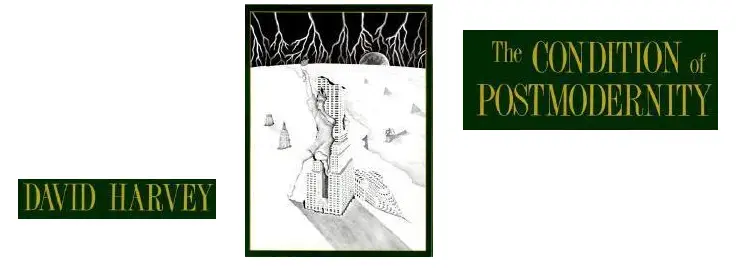Last Updated on April 1, 2018 by Karl Thompson

This is a summary of the introductory chapter of part one of this book, in which Harvey introduces us to some basic definitions of modernity and postmodernity.
Part 1 – The Passage from Modernity to Postmodernity in Contemporary Culture
Starts with a quote by Max Weber…
‘the general views of life and the universe can never be the products of increasing empirical knowledge, and that the highest ideals, which move us most forcefully, are always formed only in the struggle with other ideals.’
1. Introduction

Raban rejected the thesis of a city tightly stratified by occupation and class, depicting instead the spread of individualism and entrepreneurialism, where social distinction was broadly conferred by possessions and appearance – the city was an emporium of styles, and primarily about the production of signs and images – something not rationally planned and rigid, but more like a theatre in which people acted out a multiplicity of roles. Rather than a place of lost-community, the city was a labyrinth, a honeycomb, consisting of diverse networks.
Harvey recognises that this is just one view of the city, but his purpose is not to judge its accuracy, but to ask why this particular view was so well received at that time.
Raban’s vision of the city was one which could not be disciplined by rational planning, one where imagination and fact fused together – his vision appealed to ‘subjective individualism’ – casting it as a place where people were relatively free to act and where personal identity was fluid. – (it’s sort of in the title ‘soft city’…..
‘The city invites you to remake it into a shape you can live in…. cities, unlike villages and small towns are plastic by nature. We mould then in our images: they, in turn, shape us by the resistances they offer.”
Raban also recognised the downsides of urban living – too many people lost their way in the labyrinth and it was too easy for us to lose each other as well as ourselves; there was a lot of violence beneath the surface, and although we were free to play with images, ‘creative entrepreneurialism’ had the potential to impose an ‘imperialism of taste’ which could create a new hierarchy of values….
‘the very plastic qualities which make the great city the liberator of human identity also cause it to be especially vulnerable to to psychosis and totalitarian nightmare’.’
Raban was influenced by Roland Barthes, and Le Corbusier’s modernist style of architecture is the bête noire for Raban, however the text is more than simply anti-modern, and the tension between the two mark this text out as a sign that postmodernism has arrived.
Harvey now points to Cindy Sherman as one of the major figures of the postmodern movement.
Sherman’s work parallels the theme of the plasticity of the city in Raban’s work – All Sherman does is take photographs of herself in different walks of life (and somehow convinces people to pay her enough to earn a living doing it?!) – emphasising the ‘malleability of appearances and surfaces and self-referential positioning of the authors as subjects’.
So what is this postmodernism of which many now speak?
No one agrees as to what is meant by the term except that ‘postmodernism’ represents some kind of reaction to or departure from ‘modernism’. Since the meaning of modernism is also very confused, the reaction or departure known as postmodernism is doubly so.
Terry Eagleton (a literary critic) defined postmodernism thus in 1987:
The typical postmodernist artefact is playful, self-ironizing and even schizoid; and that it reacts to the austere autonomy of high modernism by impudently embracing the language of commerce and the commodity. Its stance towards cultural tradition is one of irreverent pastiche, and its contrived depthlessness undermines all metaphysical solemnities, sometimes by a brutal aesthetics of squalor and shock.’
The editors of the architectural journal PRECIS (1987) see postmodernism as a legitimate reaction to the monotony of universal modernism’s vision of the world.
‘Generally perceived as positivistic, technocentric, and rationalistic, being about linear progress, absolute truths, rational planning of ideal social orders and the standardisation of knowledge and production. Postmodernism by way of contrast privileges heterogeneity and differences as liberative force in the redefinition of cultural discourse. Fragmentation, indeterminacy and intense distrust of all universal or totalising discourses are the hallmark of postmodernist thought.’
Examples of postmodernism include:
– The rediscovery of pragmatism in philosophy – Rorty (1979)
– New ideas about the philosophy of science – Kuhn (1962) and Feyerbrand (1975)
– Foucault’s focus on polymorphous correlations in place of simple or complex causality in history.
– New developments in maths emphasising indeterminacy – chaos theory a fractal geometry.
– the concern for ‘the other’ in anthropology and politics.
What all of the above have in common is the a rejection of metanarratives (large scale theoretical interpretations purportedly of universal application.
Eagleton’s full description of postmodernism…
‘Post-modernism signals the death of such ‘metanarratives’ whose secretly terroristic function was to ground and legitimate the illusion of a ‘universal’ human history. We are now in the process of wakening from the nightmare of modernity, with it manipulative reason and fetish of the totality, into the laid-back pluralism of the post-modern, that heterogeneous rnage of life-styles and language games which has renounced the nostalgic urge to totalise and legitimate itself… Science and philosophy must jettison their grandiose metaphysical claims and view themselves more modestly as just another set of narratives’.

Leave a Reply